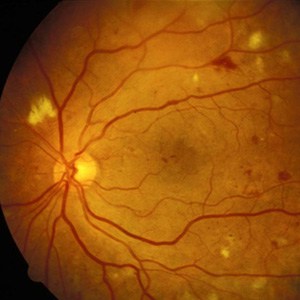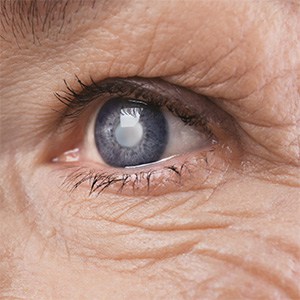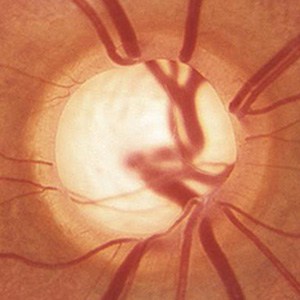INNOVATIVE TECHNOLOGY
WORLD CLASS SERVICE
Digital Eye Exam

DIGITAL EYE EXAM
At Eye Theory, we utilize the latest innovative technology in the eye care industry.
Our digital eye exam includes:
- VRX Digital Refraction System
- Optomap Retinal Imaging
- Icare Tonometry (no more air puffs)
- Octopus 600 Perimetry Testing
Diabetic Eye Exam

DIABETIC EYE EXAM
Diabetics are at risk for developing diabetic retinopathy, a condition in which elevated blood sugar levels damage the blood vessels in the eye. This results in hemorrhaging and can lead to neovascularization (growth of fragile blood vessels).
Diabetic retinopathy can be diagnosed with a dilated fundus exam or retinal imaging. There are two main classifications of diabetic retinopathy:
- Nonproliferative Diabetic Retinopathy (NPDR) – The less severe form of diabetic retinopathy, which is classified by the presence of microaneurysms, cotton wool spots, venous bleeding or intraretinal microvascular abnormalities.
- Proliferative Diabetic Retinopathy (PDR) – NPDR progresses to PDR once neovascularization develops.
- Symptoms of diabetic retinopathy include:
Increased number of floaters - Blurred vision
- Dark areas in field of vision
Treatment options include:
- Lower blood sugar level
- Surgery may be required in severe cases
We strongly recommend routine diabetic eye exams for diabetic patients. Early detection is key to managing diabetic retinopathy.
Lasik Consultation

LASIK CONSULTATION
A good LASIK candidate is:
- Over the age of 18
- Stable prescription
- No corneal disorders or other underlying eye diseases
- Adequate corneal thickness
- No dry eye syndrome
Benefits of LASIK:
- No hassle of glasses and contacts
- Quick and painless procedure
- Short recovery time
If you are considering LASIK or have any additional questions, please give us a call at 832.831.7386.
Dry Eye Center

DRY EYE CENTER
A recent online poll discovered that over 50% of Americans over the age of 18 suffer from dry eye symptoms.
Symptoms of dry eye syndrome include:
- Burning
- Itching
- Aching
- Dryness
- Blurred vision
- Light sensitivity
- Red eyes
Dry eyes result from not being able to produce enough tears or producing poor-quality tears that evaporate too quickly.
This can be caused by:
- Low blink rate
- Lagophthalmos (incomplete eyelid closure)
- Decreased function of the lacrimal gland
- Meibomian Gland Disease
- Contact lens abuse
- Medications such as antihistamines, decongestants, blood pressure medications and antidepressants
- Environmental conditions such as smoke and wind
- LASIK
Treatment for dry eyes depend on the underlying cause. Treatment options include:
- Medications such as Restasis, Xiidra, or Cequa
- Heating and expressing the meibomian glands
- Zocular Eyelid System Treatment
- Amniotic membranes
- Punctal plugs
- Artificial tears & warm compresses
- Vitamins such as omega 3s
At Eye Theory, we specialize in the treatment of dry eye syndrome. Call 832.831.7386 to schedule a dry eye evaluation.
Medical Eye Care

MEDICAL EYE CARE
Eye infections can be bacterial, viral or fungal in nature. Common causes of eye infections include:
- Contact lens abuse
- Trauma
- Viruses such as herpes
Symptoms of eye infections include:
- Pain
- Light sensitivity
- Discharge or crusting
- Watering
- Redness
- Blurred vision
Treatment depends on the cause of the infection. Treatment options include:
- Medication
- Bandage contact lenses
Our doctors are highly trained in the diagnoses and treatment of eye infections. If you have an emergency, we will make sure you are taken care of the same day.
SPECIALTY CONTACT LENSES

SPECIALTY CONTACT LENSES
Myopia (nearsightedness) occurs in 30-40% of adults in the US and Europe, and up to 80% of the Asian population. Myopia has increased by 66% in the United States since 1971. Severe cases of myopia can cause:
- Early cataract development
- Increased likelihood to get glaucoma
- Increased risk of retinal detachments
Specialty contact lenses can slow down and even stop the progression of myopia. The two most common lenses used are:
- Orthokeratology or Ortho-K
- Multifocal Contact Lenses
Orthokeratology is the most effective method of myopia control. The mechanism of action is similar to braces but for the eyes. By wearing them overnight, the cornea is reshaped to focus light directly onto the retina.
Benefits of corneal refractive therapy include:
- Vision correction without surgery
- Rapid results – most patients notice a significant improvement the following day
- Cheaper than LASIK
- Can be performed on children
If you are interested in orthokeratology or have any additional questions, please give us a call at 832.831.7386.
CATARACT MANAGEMENT

CATARACT MANAGEMENT
The majority of cataracts are a result from aging. However, cataracts can be caused by other factors such as congenital deformities, trauma and medications.
Symptoms of cataracts include:
- Blurred vision
- Increased halos and glare
- Poor night vision
Once cataracts are mature enough, they can be replaced with intraocular lenses through cataract surgery. Different types of intraocular lenses include:
- Multifocal intraocular lenses
- Astigmatism correcting lenses
- Monofocal lens
- Single vision lenses
At Eye Theory, we co-manage with the nation’s leading cataract surgeons to provide the highest quality service. We perform pre- and post-operative care to monitor the healing process and treat any complications that occur.
GLAUCOMA MANAGEMENT

GLAUCOMA MANAGEMENT
Glaucoma is a condition in which elevated intraocular pressure damages the optic nerve. It is a silent disease that results in gradual peripheral vision loss and can lead to complete blindness if not treated.
Symptoms of Glaucoma include:
- Large cup to disc ratio
- Asymmetric cupping between nerves
- High intraocular pressure
- Peripheral vision loss
- Loss of nerve fiber layer
Glaucoma can be diagnosed with special testing including:
- Visual field test
- Dilated fundus exam (DFE)
- Tonometry
- Pachymetry
- Optical coherence tomography (OCT)
Treatment involves using medication to lower the intraocular pressure. In rare cases, surgery may be required to lower the pressure. Our doctors are Optometric Glaucoma Specialists certified to manage glaucoma.
MACULAR DEGENERATION MANAGEMENT

MACULAR DEGENERATION MANAGEMENT
Macular degeneration (AMD) is the leading cause of vision loss in America. The macula is responsible for the central vision. Macular degeneration occurs when protein deposits called drusen build up in the macula and damage the cells.
There are two stages of macular degeneration:
- Dry AMD – the less severe form of macular degeneration, which is classified by the presence of drusen deposits in the macula.
- Wet AMD – Dry AMD progresses to Wet AMD once neovascularization develops.
Risk factors for macular degeneration include:
- Age: Higher risk in those 55 and older
- Race: Caucasians are at greatest risk
- Smoking: Doubles the risk
- Genetics: Higher risk if you have a family history
Symptoms of macular degeneration include:
- Gradual loss of central vision
- Objects and lines may appear distorted
Macular degeneration can be diagnosed with:
- Dilated fundus exam or retinal photography
- Dark adaptation testing
- Optical coherence tomography
- Amsler grid
- Visual field test
There is currently no cure for macular degeneration but there are ways to slow down the progression and treat the side effects.
Treatment options include:
- Supplements such as lutein, zeaxanthin, vitamin C, vitamin E and zinc
- Anti-VEGF medications
- Low vision devices
- Smoking Cessation
- Blue-light protective lenses
Like most diseases, early detection is the key to managing macular degeneration.
- DIGITAL EYE EXAM
- DIABETIC EYE EXAM
- LASIK CONSULTATION
- DRY EYE CENTER
- MEDICAL EYE CARE
- SPECIALTY CONTACT LENSES
- CATARACT MANAGEMENT
- GLAUCOMA MANAGEMENT
- MACULAR DEGENERATION MANAGEMENT

DIGITAL EYE EXAM
At Eye Theory, we utilize the latest innovative technology in the eye care industry.
Our digital eye exam includes:
- VRX Digital Refraction System
- Optomap Retinal Imaging
- Icare Tonometry (no more air puffs)
- Octopus 600 Perimetry Testing

DIABETIC EYE EXAM
Diabetics are at risk for developing diabetic retinopathy, a condition in which elevated blood sugar levels damage the blood vessels in the eye. This results in hemorrhaging and can lead to neovascularization (growth of fragile blood vessels).
Diabetic retinopathy can be diagnosed with a dilated fundus exam or retinal imaging. There are two main classifications of diabetic retinopathy:
- Nonproliferative Diabetic Retinopathy (NPDR) – The less severe form of diabetic retinopathy, which is classified by the presence of microaneurysms, cotton wool spots, venous bleeding or intraretinal microvascular abnormalities.
- Proliferative Diabetic Retinopathy (PDR) – NPDR progresses to PDR once neovascularization develops.
- Symptoms of diabetic retinopathy include:
Increased number of floaters - Blurred vision
- Dark areas in field of vision
Treatment options include:
- Lower blood sugar level
- Surgery may be required in severe cases
We strongly recommend routine diabetic eye exams for diabetic patients. Early detection is key to managing diabetic retinopathy.

LASIK CONSULTATION
A good LASIK candidate is:
- Over the age of 18
- Stable prescription
- No corneal disorders or other underlying eye diseases
- Adequate corneal thickness
- No dry eye syndrome
Benefits of LASIK:
- No hassle of glasses and contacts
- Quick and painless procedure
- Short recovery time
If you are considering LASIK or have any additional questions, please give us a call at 832.831.7386.

DRY EYE CENTER
A recent online poll discovered that over 50% of Americans over the age of 18 suffer from dry eye symptoms.
Symptoms of dry eye syndrome include:
- Burning
- Itching
- Aching
- Dryness
- Blurred vision
- Light sensitivity
- Red eyes
Dry eyes result from not being able to produce enough tears or producing poor-quality tears that evaporate too quickly.
This can be caused by:
- Low blink rate
- Lagophthalmos (incomplete eyelid closure)
- Decreased function of the lacrimal gland
- Meibomian Gland Disease
- Contact lens abuse
- Medications such as antihistamines, decongestants, blood pressure medications and antidepressants
- Environmental conditions such as smoke and wind
- LASIK
Treatment for dry eyes depend on the underlying cause. Treatment options include:
- Medications such as Restasis, Xiidra, or Cequa
- Heating and expressing the meibomian glands
- Zocular Eyelid System Treatment
- Amniotic membranes
- Punctal plugs
- Artificial tears & warm compresses
- Vitamins such as omega 3s
At Eye Theory, we specialize in the treatment of dry eye syndrome. Call 832.831.7386 to schedule a dry eye evaluation.

MEDICAL EYE CARE
Eye infections can be bacterial, viral or fungal in nature. Common causes of eye infections include:
- Contact lens abuse
- Trauma
- Viruses such as herpes
Symptoms of eye infections include:
- Pain
- Light sensitivity
- Discharge or crusting
- Watering
- Redness
- Blurred vision
Treatment depends on the cause of the infection. Treatment options include:
- Medication
- Bandage contact lenses
Our doctors are highly trained in the diagnoses and treatment of eye infections. If you have an emergency, we will make sure you are taken care of the same day.

SPECIALTY CONTACT LENSES
Myopia (nearsightedness) occurs in 30-40% of adults in the US and Europe, and up to 80% of the Asian population. Myopia has increased by 66% in the United States since 1971. Severe cases of myopia can cause:
- Early cataract development
- Increased likelihood to get glaucoma
- Increased risk of retinal detachments
Specialty contact lenses can slow down and even stop the progression of myopia. The two most common lenses used are:
- Orthokeratology or Ortho-K
- Multifocal Contact Lenses
Orthokeratology is the most effective method of myopia control. The mechanism of action is similar to braces but for the eyes. By wearing them overnight, the cornea is reshaped to focus light directly onto the retina.
Benefits of corneal refractive therapy include:
- Vision correction without surgery
- Rapid results – most patients notice a significant improvement the following day
- Cheaper than LASIK
- Can be performed on children
If you are interested in orthokeratology or have any additional questions, please give us a call at 832.831.7386.

CATARACT MANAGEMENT
The majority of cataracts are a result from aging. However, cataracts can be caused by other factors such as congenital deformities, trauma and medications.
Symptoms of cataracts include:
- Blurred vision
- Increased halos and glare
- Poor night vision
Once cataracts are mature enough, they can be replaced with intraocular lenses through cataract surgery. Different types of intraocular lenses include:
- Multifocal intraocular lenses
- Astigmatism correcting lenses
- Monofocal lens
- Single vision lenses
At Eye Theory, we co-manage with the nation’s leading cataract surgeons to provide the highest quality service. We perform pre- and post-operative care to monitor the healing process and treat any complications that occur.

GLAUCOMA MANAGEMENT
Glaucoma is a condition in which elevated intraocular pressure damages the optic nerve. It is a silent disease that results in gradual peripheral vision loss and can lead to complete blindness if not treated.
Symptoms of Glaucoma include:
- Large cup to disc ratio
- Asymmetric cupping between nerves
- High intraocular pressure
- Peripheral vision loss
- Loss of nerve fiber layer
Glaucoma can be diagnosed with special testing including:
- Visual field test
- Dilated fundus exam (DFE)
- Tonometry
- Pachymetry
- Optical coherence tomography (OCT)
Treatment involves using medication to lower the intraocular pressure. In rare cases, surgery may be required to lower the pressure. Our doctors are Optometric Glaucoma Specialists certified to manage glaucoma.

MACULAR DEGENERATION MANAGEMENT
Macular degeneration (AMD) is the leading cause of vision loss in America. The macula is responsible for the central vision. Macular degeneration occurs when protein deposits called drusen build up in the macula and damage the cells.
There are two stages of macular degeneration:
- Dry AMD – the less severe form of macular degeneration, which is classified by the presence of drusen deposits in the macula.
- Wet AMD – Dry AMD progresses to Wet AMD once neovascularization develops.
Risk factors for macular degeneration include:
- Age: Higher risk in those 55 and older
- Race: Caucasians are at greatest risk
- Smoking: Doubles the risk
- Genetics: Higher risk if you have a family history
Symptoms of macular degeneration include:
- Gradual loss of central vision
- Objects and lines may appear distorted
Macular degeneration can be diagnosed with:
- Dilated fundus exam or retinal photography
- Dark adaptation testing
- Optical coherence tomography
- Amsler grid
- Visual field test
There is currently no cure for macular degeneration but there are ways to slow down the progression and treat the side effects.
Treatment options include:
- Supplements such as lutein, zeaxanthin, vitamin C, vitamin E and zinc
- Anti-VEGF medications
- Low vision devices
- Smoking Cessation
- Blue-light protective lenses
Like most diseases, early detection is the key to managing macular degeneration.
SEE GREAT
Glasses and Contacts
We understand everybody is different. Our doctors make recommendations based off your lifestyle needs to help you achieve your maximum visual potential.
FEEL GREAT
Infection · Trauma · Loss of vision
CO-MANAGEMENT
LASIK and Cataract


